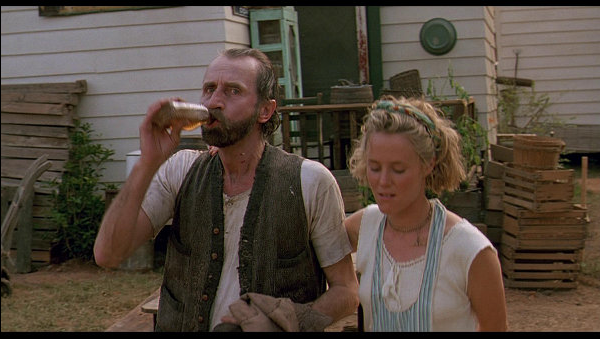
Released in 1991, Fried Green Tomatoes was a critical and commercial success, offering audiences a warm, intergenerational story of friendship, resilience, and Southern charm. However, watching the film today — over three decades later — reveals a complex web of choices, omissions, and cultural blind spots that reflect the era it was made in. While still beloved, Fried Green Tomatoes could not be made the same way in today’s more socially conscious and inclusive cinematic landscape. And for good reason.
1. Queer Representation Would Be Explicit, Not Subtextual
In the 1990s, mainstream Hollywood shied away from openly queer characters, especially in films aimed at general audiences. Idgie Threadgoode and Ruth Jamison’s relationship in Fried Green Tomatoes is clearly romantic in Fannie Flagg’s novel, but the film reduced it to platonic friendship — or at most, emotionally ambiguous companionship.
Today, audiences and critics alike expect transparency and authenticity when it comes to LGBTQ+ storytelling. Films like Portrait of a Lady on Fire and shows like Gentleman Jack have proven that same-sex love stories can be told with nuance, sensuality, and pride — without being hidden in metaphor. If Fried Green Tomatoes were made today, Idgie and Ruth’s love would likely be portrayed openly and fully, affirming their relationship instead of softening it for heteronormative comfort.
2. Race and the Southern Setting Would Demand a Deeper Reckoning
Set in Alabama during the Great Depression and Jim Crow era, Fried Green Tomatoes only scratches the surface of the racial injustices that defined the time. Characters like Sipsey and Big George — both Black — play supportive, even heroic roles, but their own narratives are not centered. They exist largely in service to the white protagonists, and their agency is limited.
A contemporary retelling would likely give greater attention to the Black experience in the South, especially given the café’s racially integrated setting — a significant political and social stance that goes underexplored. Today’s audiences would expect a more robust examination of the dangers faced by Black characters, and a more critical portrayal of the systemic racism that shaped their lives.
Films like The Help and Green Book have received backlash for centering white characters in Black stories. A modern Fried Green Tomatoes would face pressure to avoid the same misstep — perhaps by including Black perspectives more fully, or by collaborating with Black writers and directors to ensure authenticity.
3. Gender Roles Would Be Questioned Even More Boldly
One of the film’s central themes is the quiet rebellion of women against patriarchal norms. Ruth escapes an abusive marriage. Idgie rejects societal expectations of femininity. Evelyn transforms from a timid housewife into a confident, assertive woman.
While these arcs remain powerful, a modern adaptation would likely push them further. Evelyn’s feminist awakening, for example, might be framed less around “pleasing herself for the first time” or yelling “Towanda!” at bad drivers, and more around systemic sexism, workplace inequality, or intersectionality.
Moreover, a 2020s version might incorporate non-binary or trans characters, offering a broader lens on gender identity beyond the binary categories that defined the original.
4. Casting and Creative Control Would Likely Be More Inclusive

Fried Green Tomatoes was written by Fannie Flagg and co-scripted by Carol Sobieski — both women — which was groundbreaking at the time. Still, the cast and production team were overwhelmingly white and cisgender. Today, greater attention would be paid to inclusion behind the camera, not just in front of it.
Diverse casting is now a major industry standard, not just for moral reasons, but for narrative depth. Characters like Sipsey and Big George would likely be portrayed by Black actors with more prominence and storylines. Meanwhile, LGBTQ+ actors might be chosen to play queer-coded characters like Idgie, contributing to more authentic performances and representation.
5. Audiences Would Demand Clearer Accountability and Justice
One of the most controversial parts of Fried Green Tomatoes is the murder of Frank Bennett — Ruth’s abusive husband — and the subsequent disposal of his body, which may or may not have ended up in a barbecue pit. While the film plays this off with dark humor, it sidesteps the moral ambiguity of vigilantism, especially considering the racial implications of a Black man (Big George) being suspected of the crime.
In today’s cultural climate, this plotline would likely be handled with greater nuance. Who gets to exact justice? Who pays the price for it? How do race, gender, and power affect those decisions? Modern audiences are more attuned to the complexities of justice, especially in communities historically denied it.
6. Social Media Would Shape the Conversation Around the Film
When Fried Green Tomatoes was released, the public conversation happened in film reviews and coffee shops. Today, social media platforms like Twitter, TikTok, and Letterboxd would explode with discourse: Was Idgie a lesbian icon? Did the film whitewash the South? Were Evelyn’s actions feminist or just chaotic?
The democratization of film criticism means that no film is immune to public scrutiny — and that can be a powerful thing. A new Fried Green Tomatoes would need to be ready for immediate feedback, both celebratory and critical, from diverse audiences worldwide.
7. The Ending Might Be Less Ambiguous — and More Empowering
The original film ends with Evelyn feeling empowered and Ninny revealing a possible twist about her identity. While poetic, the ending is ambiguous, particularly regarding Idgie and Ruth’s legacy. Did they get to live happily ever after? Did anyone ever honor their love?
A modern adaptation might choose to answer those questions more directly. Perhaps we would see flash-forwards to a community remembering their café, or Ruth and Idgie’s love story passed down as Southern folklore. The film might lean into a more triumphant, rather than wistful, tone — especially given today’s appetite for stories of resilience, justice, and joyful queer love.
Conclusion: A Beloved Film, But Not Untouchable
Fried Green Tomatoes remains a cinematic treasure — a film that, in many ways, was ahead of its time. But like all art, it is a product of its era. Its silences, its euphemisms, and its narrative gaps speak to the cultural limitations of the early 1990s.
If it were made today, it would need to be bolder, more inclusive, and more honest. That’s not a criticism of the original, but a testament to how far we’ve come — and how much further we still have to go. Stories like Idgie and Ruth’s deserve to be told with the fullness of their truth, and in today’s world, there’s room — and demand — for exactly that.
